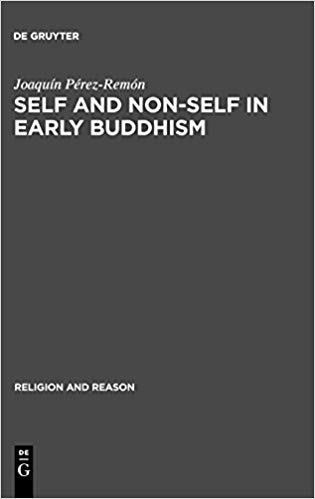(Created page with "{{Book |FullTextRead=No |AddRelatedTab=No }}") |
No edit summary |
||
| (31 intermediate revisions by the same user not shown) | |||
| Line 1: | Line 1: | ||
{{Book | {{Book | ||
|FullTextRead=No | |FullTextRead=No | ||
|BookToc=* {{i|Preface|V}} | |||
* {{i|List or Sources and Abbreviations|XI}} | |||
* {{i|Introduction|1}} | |||
* Part One: The Existential Self | |||
** {{i|1. Preliminary Remarks|7}} | |||
***{{i|How to translate the term ''attā''|7}} | |||
***{{i|Has the term ''attā'' a mere conventional sense in the Nikāyas?|10}} | |||
***{{i|The Nikayan approach to the term ''attā''|17}} | |||
** {{i|2. Attā as Man's Highest Value|20}} | |||
***{{i|The self as refuge|20}} | |||
***{{i|The self is best|26}} | |||
***{{i|In love with the self|34}} | |||
***{{i|Look for the self|37}} | |||
***{{i|''Paccattaṁ''|40}} | |||
***{{i|''Ajjhattaṁ''|43}} | |||
** {{i|3. The Self as the Moral Agent|49}} | |||
***{{i|Moral energy of the self|50}} | |||
***{{i|Salvation in general and the self|56}} | |||
***{{i|The chariot and the charioteer|57}} | |||
***{{i|Knowledge of the self|63}} | |||
***{{i|Manifestation of the self|67}} | |||
** {{i|4. The Self and Moral Evil|77}} | |||
***{{i|The metaphysical self, as such, is above moral good and evil|77}} | |||
***{{i|The moral self as the cause of moral evil|80}} | |||
***{{i|The moral self under the influence of moral shortcomings|82}} | |||
***{{i|The moral self 'wounded and killed' by evil|83}} | |||
***{{i|''Asmimāna'' as the root of all moral evil|85}} | |||
** {{i|5. Towards Perfection|90}} | |||
***{{i|The self as related to moral good|90}} | |||
***{{i|Self-exertion|94}} | |||
***{{i|Self-control|98}} | |||
***{{i|Purification of the self|104}} | |||
** {{i|6. The Self and Perfection|108}} | |||
***{{i|Perfection of the self|108}} | |||
***{{i|Self-stability|109}} | |||
***{{i|'He dwells with a self brahma-become'|113}} | |||
***{{i|Full blossoming of the self|118}} | |||
***{{i|The self and ''nibbāna''|122}} | |||
***{{i|Nibbutatto|129}} | |||
** {{i|7. The Self as Related to Kamma and Rebirth|131}} | |||
***{{i|The self and ''kamma''|131}} | |||
***{{i|The self and rebirth|143}} | |||
** {{i|8. A Brief General Assessment of the First Part|148}} | |||
* Part Two: The Metaphysical Self | |||
** {{i|9. The Doctrine of ''Anattā'' can co-exist with the Reality of ''Attā''|153}} | |||
** {{i|10. The Doctrine of Non-self Taught Through<br/>the Denial of Positive Terms|158}} | |||
***{{i|This is not my self|158}} | |||
***{{i|He does not regard the ''khandas'', etc., either as the self or the self as<br>qualified by them|173}} | |||
***{{i|Void of the self or belongs to the self|183}} | |||
***{{i|What is not your own|186}} | |||
***{{i|Permanence, happiness, self ''vs''. impermanence, pain, non-self|189}} | |||
***{{i|As alien, not as the self|190}} | |||
** {{i|11. The Doctrine of the Non-Self Taught Through the Predication of the<br>Negative Term ''Anattā''.|195}} | |||
***{{i|Connection with the preceding chapter|196}} | |||
***{{i|Scope of the' ''annattā'' statements'|198}} | |||
***{{i|Intimate relationship between ''anattā' and ''dukkha'''|204}} | |||
***{{i|The awareness of non-self|205}} | |||
***{{i|''Anattā'' proclaimed by means of universal statements|208}} | |||
***{{i|Reasons given to assert that something is ''annattā''|222}} | |||
** {{i|12. Asmimāna, Sakkāyadiṭṭhi, ''Sassatavāda'' and Ucchedavāda|227}} | |||
** {{i|13. Self and Non-Self After Liberation|268}} | |||
***{{i|Buddha was not a nihilist|269}} | |||
***{{i|Transcendence of the self|276}} | |||
***{{i|Moral transcendence of the self|278}} | |||
***{{i|Metaphysical transcendence of the self|280}} | |||
***{{i|The ''abyākatā pañhā'' and the ''sakkāyaddiṭṭi'' unanswered|294}} | |||
***{{i|Reasons for keeping the ''abyākatā pañhā'' unanswered|294}} | |||
** {{i|14. Recapitulation|301}} | |||
* {{i|Notes|306}} | |||
* {{i|Selected Bibliography|384}} | |||
* {{i|Glossary of Terms|388}} | |||
* {{i|Table of Scriptural Passages Commented or Quoted|393}} | |||
* {{i|Index of Names and Subjects|401}} | |||
|AddRelatedTab=No | |AddRelatedTab=No | ||
|StopPersonRedirects=No | |||
}} | }} | ||
Latest revision as of 11:40, 7 October 2020
The following is an extract from a review of Self and Non-Self in Early Buddhism by Vijitha Rajapakse published by the Journal of the International Association of Buddhist Studies 8, no.1 (1985): 122–25:
Pérez-Remón's book is analytical in nature, and its immediate aim is to provide an interpretative study of the anattā doctrine as it appears in the earlier parts of the Pali canon, namely the Nikaya literature. He describes the religious views elaborated in these contexts as a soteriology, that is to say a system of moral training which considers salvation to be its prime goal. Buddhist writings on the self, he argues, are not as clear and unambiguous as is often supposed. He does not, in particular, believe that one could regard them in a purely negative light, after the manner of certain Theravada exponents. The use and the import of "self" (attā) and "non-self" (anattā) are of course central to this study. In order to facilitate his inquiry into these key terms, he introduces some important distinctions which appear for the most part to be philosophical in nature. First, there is the distinction between the self in its existential and metaphysical signification; and second, between two senses of the term non-self, one qualified and the other absolute. Previous interpretations of the anattā doctrine have not revolved around distinctions of this kind. Perez-Remon, however, is of the view that it is necessary to focus on them in order to gain a true insight into early Buddhist thinking on the nature and existence of the self.
For the complete review, click here
| Citation | Pérez-Remón, Joaquín. Self and Non-Self in Early Buddhism. The Hague, Neth.: Mouton Publishers, 1980. |
|---|---|

